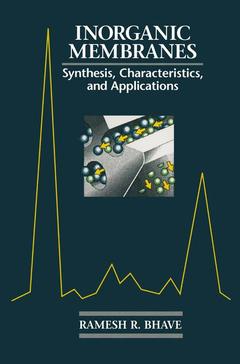Description
Inorganic Membranes Synthesis, Characteristics and Applications, 1991
Synthesis, characteristics, and applications
Author: Bhave R.
Language: English
Subjects for Inorganic Membranes Synthesis, Characteristics and...:
Keywords
biotechnology; filtration; food; ultrafiltration; wastewater
Publication date: 02-2012
336 p. · 15.2x22.9 cm · Paperback
336 p. · 15.2x22.9 cm · Paperback
Description
/li>Contents
/li>
Here is the first book devoted completely to inorganic membrane separations and applications. It provides detailed information on all aspects of the development and utilization of both commercial and developmental inorganic membranes and membrane-based processes, pointing out their key advantages and limitations as separation tools. Characteristics, technological advances, and future applications of inorganic membranes are discussed in depth. An overview of the origins of these membranes provides a basis for understanding emerging technologies in the field. Coverage of thermal, chemical, surface, and mechanical properties of inorganic membranes includes discussion of pore diameter, thickness, and membrane morphology. You'll gain valuable insights into membrane modification, as well as the design and operation of membrane filtration units. Also included are sections on how to analyze mechanisms that affect flux feature models for prediction of micro- and ultrafiltration flux that help you minimize flux decline. Descriptions of cross-flow membrane filtration and common operating configurations clarify the influence of important operating parameters on system performance. Parameters influencing solute retention properties during ultrafiltration are identified and discussed or treated in detail.
Preface; Foreword; The developing use of inorganic membranes: a historical perspective; Synthesis of inorganic membranes; General characteristics of inorganic membranes; Liquid filtration and separation with inorganic membranes: operating considerations and some aspects of system design; Gas separations with inorganic membranes; Inorganic membrane reactors to enhance the productivity of chemical processes; Inorganic membranes in food and biotechnology applications; Inorganic membranes for the filtration of water, wastewater treatment and process industry filtration applications; Appendix.
© 2024 LAVOISIER S.A.S.

